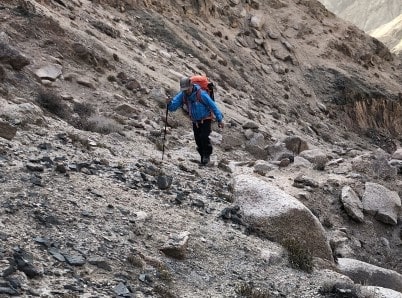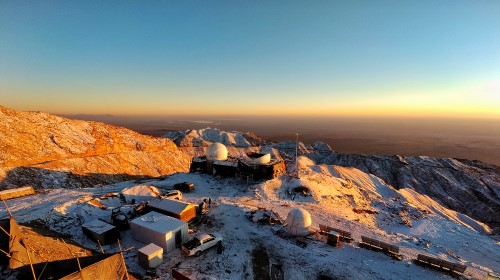Astronomers in China have found that the Tibetan Plateau offers conditions that make it ideal for future gigantic optical-based telescopes. The researchers report that a mountain near the town of Lenghu (“cold lake”) in Qinghai Province has observing conditions similar to existing astronomy meccas in the Hawaiian mountains and Chilean deserts.
For years, astronomers had hoped to find a good observing site on the Tibetan Plateau — known as “the roof of the world” — due to its high altitude, dryness, and minimal light pollution. However, the region’s harsh environment makes it extremely challenging to collect reliable and continuous observation data. Indeed, there was a general belief among astronomers that sandstorms ruled out Lenghu while other nearby locations suffer from strong winds.
Lenghu site is indeed comparable in quality to the best established sites such as Chile, Hawaii, and the Canary Islands for large telescopes
Michael Ashley
Since March 2018, a team led by Licai Deng from the National Astronomical Observatories of China, Chinese Academy of Sciences, has been monitoring cloudiness, night-sky brightness, air temperature, humidity, wind speed and direction at “Summit C” on Saishiteng Mountain, which lies some 4200 m above sea level.
They discovered that about 70% of the nights at the summit were clear enough for observation. As for “seeing” — a key parameter to describe the blurring of stars due to atmospheric turbulences along the light path — the median value was 0.75 arcseconds, or 1/4800 of a degree. The median night temperature variation was 2.4 °C when precipitable water vapor was lower than 2 mm for most of the night.
These parameters are like those of Mauna Kea in Hawaii, Cerro Paranal in Chile and La Palma in Spain, where the world’s most cutting-edge telescopes are located. In particular, the temperature fluctuations at the Lenghu site were much lower than the other sites, indicating very stable surface air.
In winter, temperatures on Saishiteng Mountain could drop to below -20 °C at night, which is favorable for infrared astronomy. Meanwhile, with little water vapor, Lenghu’s exceptional atmospheric transparency could open up a new window on terahertz astronomy to examine interstellar medium and better understand the origins of stars, galaxies, and the universe.
“The [work] provides convincing evidence that the Lenghu site is indeed comparable in quality to the best established sites such as Chile, Hawaii, and the Canary Islands for large telescopes,” wrote astrophysicist Michael Ashley from the University of New South Wales in his reviewer comments for the paper. “The authors should be congratulated on completing this difficult task at such a remote location.”
That view is backed up by Paul Hickson from the University of British Columbia in Vancouver, Canada, who is not involved in the research, and calls the study extensive and thorough. “Three years of data is quite good, as it covers all seasons and provides some information on year-to-year variations,” he says.
Home for future telescopes
China’s astronomical aspirations have soared in recent years, but the reality remains that the country only has a couple of 2 m-level telescopes that work in the optical band — while the largest of its kind now under construction is about 40 m in diameter. The lack of an ideal observing site being a particular bottleneck, yet that could now change thanks to the discovery of favourable conditions on Saishiteng Mountain.
Indeed, Chinese astronomers have now proposed a line-up of telescopes for the mountain site. They include a 2.5 m-aperture optical telescope now being built by the University of Science and Technology of China, which will have first light in 2023. It will be joined by a solar telescope and a telescope array called the Near Earth Object Hunter. The list could also include a 12 m-aperture telescope being proposed by the whole Chinese astronomy community to the government.

The 2021 Physics World China Briefing is now out
Deng believes, however, that Lenghu should not be just for China. With the rise of time-domain astronomy, it will serve as the only site in the eastern hemisphere to benefit the global observation of high-energy phenomena and transient events. Good astronomical sites are always in high demand — in particular given the construction deadlock at Mauna Kea – and Deng hopes that Lenghu could be home to international telescopes in the future.
Ashley, who has worked with Chinese astronomers at Antarctica’s Dome A, adds that the new site not only fills an observational gap in the eastern hemisphere but will be critical for China’s astronomical ambitions, including the chance to boost international collaboration. “My team would be more than happy to contribute part of a telescope to be put on Saishiteng Mountain on the Tibetan Plateau,” he adds.
The long road leading to Lenghu

Back in 2017, Licai Deng from the National Astronomical Observatories of China, Chinese Academy of Sciences, was having trouble with his 1 m-aperture telescope in Delingha, some 400 km east of Lenghu. As the Chinese node of the Stellar Observations Network Group (SONG) — a project which uses several telescopes around the world to observe stars and planetary systems — his observations were suffering due to light pollution caused by local economic development.
Just when Deng thought he needed a new site, officials from Lenghu invited him to check out conditions on Saishiteng Mountain. Lenghu used to be a major petroleum base in the country with over 100 000 population, but as oil fields dried up, it declined into a “ghost town” with a few hundred regular residents. The local government wanted to find a way out via astronomy-related tourism via Lenghu’s Mars-like landscape and beautiful night skies.
Deng signed a five-year contract – worth one million yuan per year — with the local government to collect scientific data and find out whether Saishiteng Mountain would make for a good astronomical site. At that point, no one had ever set foot on the summit.
“The area still has a lot of sandy days,” says Deng. However, when they made it to the top of Saishiteng Mountain for the first time, they realized that all the sand and dust particulates were well below. The sky cleared up somewhere between 3800 and 4000 m, with the summit being another two hundred meters higher. “No one could have known it without getting up there,” he says.
When the team first started the site survey, there were no roads or any other infrastructure they could use. The local government rented a helicopter to bring supplies to the site, including a 10 m-tall tower for mounting an instrument called differential image motion monitor.
Meanwhile, Deng and colleagues would hike two to three hours, carrying well over 10 kg of maintenance devices on their back to the top of the mountain. During the 18 months without roads, everyone in Deng’s team hiked dozens of times. They managed to obtain continuous measurement and kept downtime under 3%. The road to Summit C was finally finished in 2019.
Deng expects China’s national grid to reach Saishiteng Mountain soon. He has also relocated his SONG telescope to the new site. To his delight, a night sky protection policy has been written into law by the local government, banning light pollution in the future over an area of 18 000 square kilometers.
